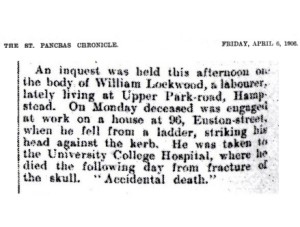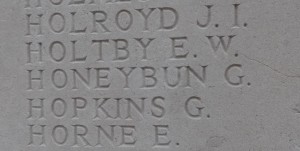Regiment: 1stBattalion, The Rifle Brigade
Service No: 5529
Date & place of birth: 3rd qtr. 1895 in Hampstead, North London
Date & place of death: 13 October 1917 (aged 22) at Poelcappelle, Belgium
When we first researched George Honeybun, there were several mysteries regarding him, including how he came to be living in Heyshott and why his name appears to have been added to the Heyshott War Memorial window after it had been commissioned. We have subsequently been contacted by George’s family, who have kindly helped us put together his story.
George Honeybun spent much of his early life living in poverty in London, ending up in the workhouse where his mother died. He was then sent to live in Heyshott. In the war, he served in The Rifle Brigade and was killed during the Battle of Passchendaele.
Family background
George Honeybun was born on 2 June 1895 in Litcham Street, near St Pancras Station in London to Frederick Joseph Honeybun (born 1860) and his wife Ellen née Kent (born 10 December 1866). Frederick and Ellen had married on 11 October 1885 and had five sons before George. At the 1891 census, Frederick, described as a carman, and Ellen (recorded as “Helen”) were living at 19 Litcham Street with their four oldest sons.
Litcham Street (which became Athlone Street in 1936) was in one of the worst slums in London at the end of the 19th century. The reformer Charles Booth described it as having “broken windows, most doors open” with “untidy and dirty rather than ragged children. Women often slatternly. The street has a rough drinking and fighting reputation rather than a criminal one.”
Frederick died on 23 June 1895, three weeks after George’s birth, at Fisherton Anger Lunatic Asylum near Salisbury, Wiltshire. On his death certificate, he is described as a “hawker, from St Pancras workhouse, London” and his cause of death was recorded as “Phthisis” (tuberculosis).
After Frederick’s death, Ellen formed a relationship with William Lockwood, who was born in St Pancras on 13 November 1851. Lockwood had at least one other child before meeting Ellen, and between 1898 and 1906 the couple had a further four children, one of whom (Lewis or Louis) died as an infant. At the 1901 census, William (described as a bricklayer) and Ellen were listed as a married couple and were living with six sons and a daughter, at 40 Preston Street, St Pancras.

On 3 April 1906, William Lockwood died after falling from a ladder while working on a house at Euston Street, London. At an inquest a few days later, a verdict of “accidental death” was recorded.
At the time of William’s death, Ellen was expecting her ninth child; Emily Lockwood was born on 2 September 1906. Two months later, on 12 November, Ellen (described as a charwoman) and her four youngest surviving children (including 11-year old George) were admitted to the workhouse at New End in the parish of St John, Hampstead. Sadly, Ellen died in the workhouse from Pulmonary Tuberculosis on 12 January 1907, leaving her four orphaned children to be raised by the parish.
On 17 May 1907, George and two sisters, Charlotte (aged 5) and Ellen (Nellie, aged 6), were discharged from the workhouse and were sent to live in Heyshott. Charlotte and Emily were placed with Henry and Anna Cox at Hoyle Farm, while George (aged 11) was sent to live (and work) with James and Rosetta Daughtry at Browns Copse, Heyshott.
On 1 April 1908, Emily (aged 19 months) was fostered with Thomas and Emily Rawlins, who renamed her Sylvia. The 1911 census records Thomas (a 32-year old ticket collector on the Metropolitan Railway) and Emily Rawlins and their daughter Sylvia living at 217 High Road, Kilburn.
In the 1911 census, George (aged 15) was lodging with James and Rosetta Daughtry at Browns Copse. On the census he gives his occupation as “help stockman on farm” and in the place of birth column, he has entered “An orphan, don’t know”. The Daughtrys lost both their sons, Basil and Ralph during the First World War, as well as a nephew, Frank, the son of James’s brother.
Military service
As war became imminent, George enlisted into the 1st Battalion of The Rifles Brigade at Horsham in July 1914. On his enlistment papers, he gave his place of birth as Hampstead, in north London. Although the battalion were sent to France as reinforcements at the end of August, George remained in England until 7 November 1914, when he joined the battalion at Ploergsteert Wood in the Ypres Salient.
His first major engagement would have been at the Second Battle of Ypres in Belgium in April/May 1915 followed by action in the Battle of the Somme from July 1916, especially at Le Transloy in October/November. In 1917, they were at Arras in May before returning to Belgium for the Third Battle of Ypres (Battle of Passchendaele) where they took part in the Battle of Polygon Wood in late September and the Battles of Broodseinde and Poelcappelle in October.
Death and commemoration
On 11/13 October 1917, the First Rifle Brigade took part in an attempt to take the village of Poelcappelle, in support of The Household Battalion and the 1st Battalion Royal Warwickshire Regiment. During very heavy rain, the brigade was repeatedly exposed to heavy machine gun fire and two officers and 31 men were killed, with many more missing or wounded.

George Honeybun was killed on 13 October but his body was never recovered. He is one of 35,000 men commemorated on the Tyne Cot Memorial to the Missing, four miles south from where he was killed.
 He is also commemorated on the War Memorial window in St James’s Church, Heyshott, where his name appears at the end of the “Roll of Honour”, out of alphabetical order, which would imply that it was added after the window had been commissioned, and on the war memorial at Graffham, where he is shown as having served in the Royal Artillery.
He is also commemorated on the War Memorial window in St James’s Church, Heyshott, where his name appears at the end of the “Roll of Honour”, out of alphabetical order, which would imply that it was added after the window had been commissioned, and on the war memorial at Graffham, where he is shown as having served in the Royal Artillery.
Three years after his death, in October 1920, George’s arrears of pay, including a war gratuity, (a total of £38 1s 8d) were paid to Mrs Kathleen Mary Boswell of Graffham. She was the wife of Arthur Boswell whose brother, Ernest died in 1920 from the effects of trench fever.